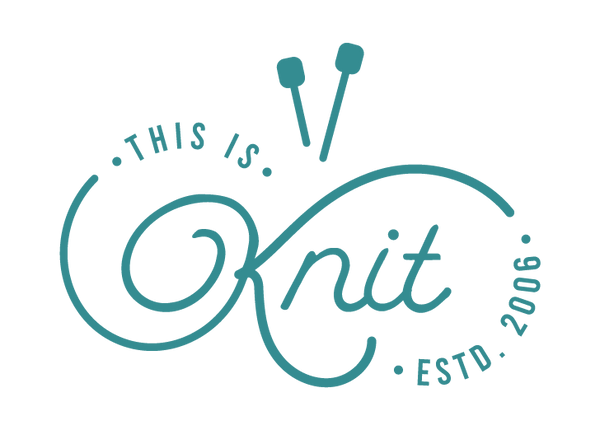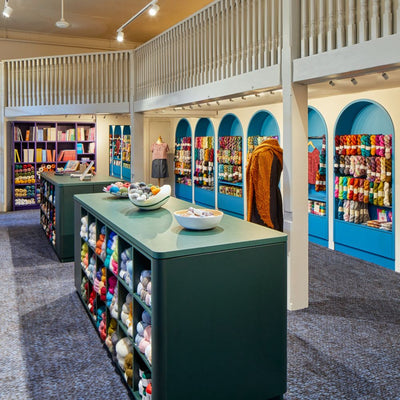All buttoned up
January 15 2013 – thisisknit
 Nothing finishes off a garment so nicely as the right buttons, neatly and securely sewn on. At this time of the year, there's a lot of snug cardigans and jackets under way, so a post on sewing on buttons is timely.
First of all, not all buttons are alike. In the picture above, you can see the two basic kinds: on the left, buttons with holes that go right through the face of the button, on the right, buttons with shanks. Buttonshanks aren't just decorative: they serve a useful purpose in holding the button up proud of the fabric it's attached to avoid puckering when you attach it, with plenty of room for the extra layer of fabric that holds the buttonhole. Here's another view of a shanked button:
Nothing finishes off a garment so nicely as the right buttons, neatly and securely sewn on. At this time of the year, there's a lot of snug cardigans and jackets under way, so a post on sewing on buttons is timely.
First of all, not all buttons are alike. In the picture above, you can see the two basic kinds: on the left, buttons with holes that go right through the face of the button, on the right, buttons with shanks. Buttonshanks aren't just decorative: they serve a useful purpose in holding the button up proud of the fabric it's attached to avoid puckering when you attach it, with plenty of room for the extra layer of fabric that holds the buttonhole. Here's another view of a shanked button:
 In what follows, we'll be focussing mostly on unshanked buttons, because they need a little bit of extra care and attention.
All you need to attach a button securely to your fabric is the button itself, yarn or thread for sewing it on, a needle and a match. A match? We'll explain. But first, tie a knot in the end of the thread and skim that end through the fabric on the wrong side (for more on weaving in on the wrong side, check out this blog post). We're using a contrasting colour here for expository purposes, but most of the time leftover yarn from the garment will work splendidly.
In what follows, we'll be focussing mostly on unshanked buttons, because they need a little bit of extra care and attention.
All you need to attach a button securely to your fabric is the button itself, yarn or thread for sewing it on, a needle and a match. A match? We'll explain. But first, tie a knot in the end of the thread and skim that end through the fabric on the wrong side (for more on weaving in on the wrong side, check out this blog post). We're using a contrasting colour here for expository purposes, but most of the time leftover yarn from the garment will work splendidly.
 Bring the needle and thread out to the right side, just where you want your button to sit, and hold the button in place, with the match between the button and the fabric. If you don't have a match, a cable needle will work, or a toothpick or anything of similar size and thickness. The match puts a little distance between the fabric and the back of the button, and that's what you're aiming for.
Bring the needle and thread out to the right side, just where you want your button to sit, and hold the button in place, with the match between the button and the fabric. If you don't have a match, a cable needle will work, or a toothpick or anything of similar size and thickness. The match puts a little distance between the fabric and the back of the button, and that's what you're aiming for.
 Now sew your button in place, working around the match by stitching forward to the right side on one side of it, through the buttonholes and back to the wrong side on the other side of it.
Now sew your button in place, working around the match by stitching forward to the right side on one side of it, through the buttonholes and back to the wrong side on the other side of it.
 Four or five passes through the buttonholes should be enough to hold the button firmly in place.
Four or five passes through the buttonholes should be enough to hold the button firmly in place.
 When you're at that stage, bring the needle back to the right side, between the button and the fabric, and pull the match out.
When you're at that stage, bring the needle back to the right side, between the button and the fabric, and pull the match out.
 You'll find that the button is now attached to the fabric by a little stalk of thread. Because the match determined the length of the stalk, it'll be all neat and uniform.
Now wind the thread around the stalk three or four times - in effect, you're making a little customised buttonshank from the thread:
You'll find that the button is now attached to the fabric by a little stalk of thread. Because the match determined the length of the stalk, it'll be all neat and uniform.
Now wind the thread around the stalk three or four times - in effect, you're making a little customised buttonshank from the thread:
 The result will be a better-sitting button, a neater closure and less wear and tear to your finished garment.
The second last step is to bring the thread back to the wrong side and weave it in neatly:
The result will be a better-sitting button, a neater closure and less wear and tear to your finished garment.
The second last step is to bring the thread back to the wrong side and weave it in neatly:
 And the very last step is to snip off the wee knot that you used to hold the thread in place right at the very beginning:
And the very last step is to snip off the wee knot that you used to hold the thread in place right at the very beginning:
 And there you are: a handsome button securely sewn on to your cardigan, with your little shank leaving comfy room for the other layer of knitting or crochet when you've buttoned up against the cold.
And there you are: a handsome button securely sewn on to your cardigan, with your little shank leaving comfy room for the other layer of knitting or crochet when you've buttoned up against the cold.
 If your chosen buttons already have a shank, then there's even less to do: weave the thread in at the beginning, sew the button on with four or five turns through the hole in the shank, bring the thread to the wrong side and weave in again.
And what if your buttons aren't functional? What if they're just for decoration, like the eyes in Kate Davies' Owls? Then you might want to consider the button technique we talked about in this post.
The weather's forecast to get cold and stay cold for a while, so button up well and stay warm out there.
If your chosen buttons already have a shank, then there's even less to do: weave the thread in at the beginning, sew the button on with four or five turns through the hole in the shank, bring the thread to the wrong side and weave in again.
And what if your buttons aren't functional? What if they're just for decoration, like the eyes in Kate Davies' Owls? Then you might want to consider the button technique we talked about in this post.
The weather's forecast to get cold and stay cold for a while, so button up well and stay warm out there.


0 comments